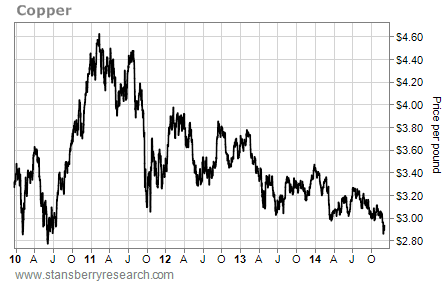 2015 may be the year of the copper trade.
2015 may be the year of the copper trade.
Copper prices took a beating over the past three and a half years… falling around 28%. And the “experts” don’t believe prices will rise next year.
But I disagree. Copper prices are about to head higher… and contrarian investors could make a lot of money.
Let me explain…
As regular Growth Stock Wire readers know, copper is a leading economic indicator. It’s in everything from batteries to refrigerators to water pipes.
[ad#Google Adsense 336×280-IA]Because of this, it tends to boom and bust with economic cycles.
In times of strong economic growth, the demand for consumer goods and building materials that include copper increases – and copper prices rise.
In times of slowing economic growth, the demand for these things decreases and copper prices fall.
This is what we’ve seen over the past few years.
As you can see in the chart below, copper prices are at their lowest point since 2010.

Many experts expect prices to stay low through next year. But as my colleague Brian Weepie showed you a few weeks ago, global copper consumption is actually increasing.
Copper demand has grown by nearly 3 million metric tons since 2008. That’s a 15% increase in the past six years. And Freeport-McMoRan, the world’s second-largest copper producer, expects demand to continue to increase 3%-4% annually over the next five years.
Based on current economic growth rates, industry analyst Wood Mackenzie reports that we’ll need an additional 7.3 million metric tons of annual copper supply by 2024.
Yet the total production of the world’s 10 largest copper mines is only 4.5 million metric tons per year.
In short, we’re about to see a massive deficit in copper.
And thanks to the collapse in oil prices, copper demand is likely headed even higher in the short term.
You see, nothing lights a fire under an economy like cheap energy.
As regular readers know, oil prices have been falling in recent months. The price of global benchmark Brent crude oil is down 44% since its peak in 2012 at $126 per barrel.
Oil provides more than one-third of the world’s energy every day. So when prices rise, people spend less on other things – helping lower economic growth.
The economic “rule of thumb” for oil prices is: for every $10 increase in the oil price, gross domestic product (GDP) growth slows by around 0.5% within two years.
For example, from May 2010 to April 2011, the spot price of Brent crude nearly doubled. It rose from just more than $67 per barrel to $124 per barrel (a $57 per barrel rise).
Meanwhile, the annual average price of Brent crude – the average price per barrel you paid if you bought oil every day – soared from $80 per barrel in 2010 to $112 per barrel in 2012. That’s a $32 per barrel rise – or 40% – in just two years.
This massive increase acted like a huge brake on the global economic recovery.
The average GDP growth of the world’s 10 largest economies was humming along at 8% in 2010 and 10% in 2011. But after oil prices rose, it collapsed to just 2% in 2012 and 2013. That’s a massive 8% decline.
The opposite is also true. As oil prices fall, people spend money on other things – boosting economic growth.
For example, as the average Brent crude oil price fell from $112 per barrel in 2012 to $102 per barrel this year, the GDP growth of the world’s 10 largest economies increased from 2% in 2012 to an estimated 5% this year.
In short, lower oil prices are great for big economies around the world. With oil prices down more than $44 since June 2014, world economic growth should increase in the months ahead – which will drive copper demand higher. And more demand than supply will be great for copper prices.
Copper prices haven’t found a bottom yet – but when they do, there’s big upside potential. That’s why 2015 could be the year of the copper trade. We’ll let you know when it’s time to get in.
Good investing,
Matt Badiali
[ad#stansberry-ps]
Source: Growth Stock Wire

